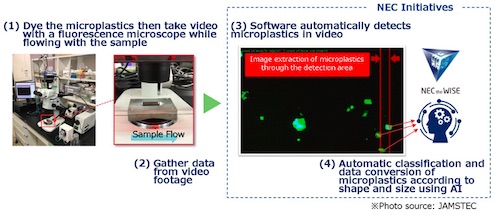
TOKYO, Jul 3, 2020 - (JCN Newswire) - NEC Corporation (TSE: 6701), in cooperation with the Japan Agency for Marine-Earth Science and Technology (JAMSTEC), today announced the development of a system to automatically detect microplastics from seawater and sediment samples at high speed by using AI-based image recognition techniques. This development aims to increase the sophistication of microplastic measurement techniques for evaluating the dynamics and environmental impact of marine plastic waste.

In recent years, marine pollution caused by microplastics, which are minute plastic particles with a size of 5mm or less, has been expanding worldwide. As a result, there are growing concerns not only about the impact on the ecosystem but also about the adverse impact on the human body through the food chain. In order to accurately grasp the actual conditions of marine microplastics, it is necessary to analyze the number, size, and type of microplastics in each sea area and identify the source, route, and destination of the outflow.
Until now, it has been common practice to scoop seawater and sediment with fine mesh, then to use a microscope to pick and analyze each microplastic manually. However, this is not only time-consuming and labor-intensive but also has the problem of underestimating the volume of small particles of 300μm or less that pass through the mesh.
JAMSTEC, a national research and development agency that conducts comprehensive research on marine science and technology, has been engaged in research and development of technologies for automatically detecting and analyzing ocean microplastics. For this project, NEC provided a system to detect microplastics at high speed and with high accuracy using image recognition technology based on "RAPID Machine-Learning," which incorporates the deep learning technology of the state-of-the-art AI technology portfolio "NEC the WISE."
Specifically, NEC developed software that leverages JAMSTEC's R&D expertise for staining microplastics in samples with fluorescent dyes, allowing video to be taken of microplastics with a fluorescence microscope while flowing at an optimum speed for detection. The software automatically extracts image data for each microplastic that appears in these videos. Then, by utilizing AI-based image recognition technology, it is possible to automatically sort and aggregate sizes and shapes of the microplastics at a processing speed of 60 per minute. This has enabled NEC to automate and upgrade the detection of microplastics that was formerly done manually.
"It is expected that by establishing and popularizing this measurement method, and by clarifying the actual situation of microplastic pollution, we will be able to contribute to the formulation of appropriate emission regulations," said Dr. Masashi Tsuchiya, Deputy Group Leader, Marine Plastics Research Group, JAMSTEC.
"NEC has been engaged in R&D on a coastal disaster simulation system utilizing the 'Earth Simulator' JAMSTEC supercomputer*, and we will continue to strive for the realization of a sustainable society through `environmental management' with AI and other advanced technologies," said Yosuke Taira, Senior Manager, 1st Government and Public Solutions Division, NEC Corporation.
*Press release: Launch of research and development on a coastal disaster simulation system
https://www.nec.com/en/press/201707/global_20170707_05.html
About NEC Corporation
NEC Corporation has established itself as a leader in the integration of IT and network technologies while promoting the brand statement of "Orchestrating a brighter world." NEC enables businesses and communities to adapt to rapid changes taking place in both society and the market as it provides for the social values of safety, security, fairness and efficiency to promote a more sustainable world where everyone has the chance to reach their full potential. For more information, visit NEC at https://www.nec.com.

Copyright 2020 JCN Newswire. All rights reserved. www.jcnnewswire.com
